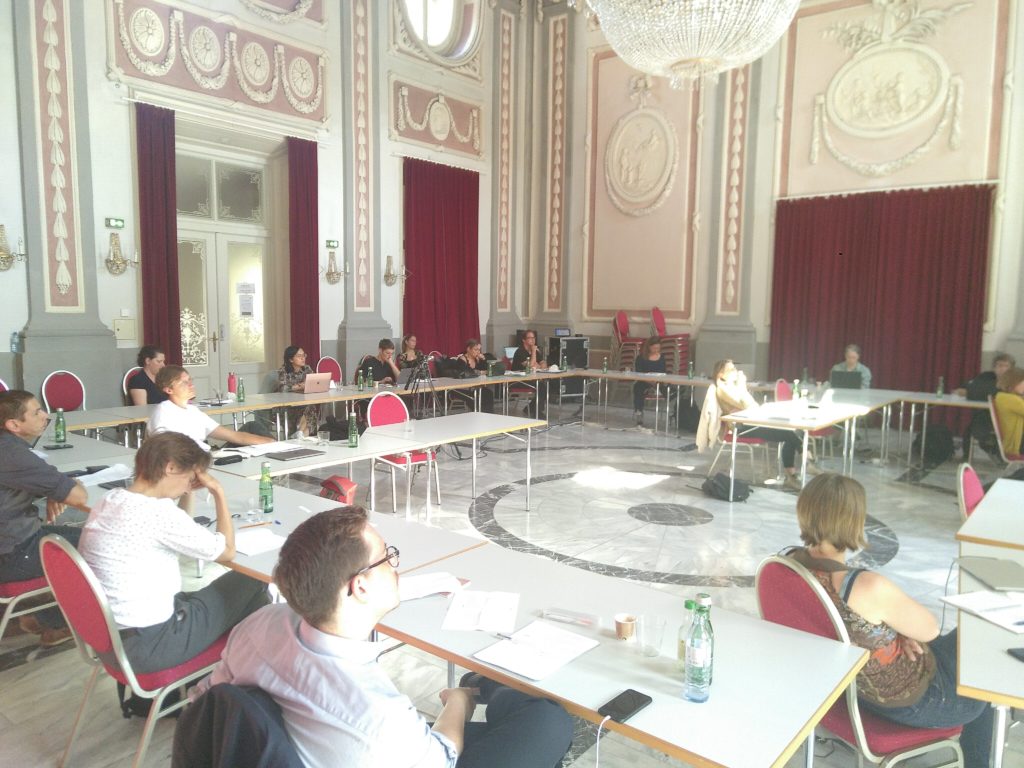After a nearly two year hiatus in which few, if any, conferences and workshops could take place in a shared physical space, STS Austria attempted to hold an event that happened primarily “in real life”. We aimed to get together in a relatively small workshop setting towards the end of summer, when the virus had somewhat loosened its grip on our lives. After much fretting and organising under considerable uncertainty, the idea ultimately worked out. Around twenty STS colleagues from within and beyond Austria met in the baroque Meerscheinschlössel at the University of Graz from the 13th to the 15th of September 2021. To be sure, it took some getting used to seeing more of most of our colleagues than their faces on a computer screen. We had to stick to some strict rules – a limited number of places in the room, restrictions on the availability of coffee – and had to make some accommodations, like only speaking with a microphone, for participants who were only virtually present due to travel restrictions. Yet in spite of a few technical hiccups, things mostly worked out, and the workshop was a good reminder of how stimulating it can be to get together in a room with our STS colleagues.
Fittingly, the title of the workshop was ‘Digital living, digital infrastructuring’ and presentations reflected both how our lives had gotten ‘more digital’ over the past two years, and covered a wide range of other areas in which digital technologies take shape together with the previously ‘analog’ world. A first panel addressed the omnipresence of some of the major digital platforms – including e.g. Facebook and Google – in our everyday lives, and the ways they have thus become infrastructural to a host of social activities. The view of online platforms as infrastructures resulted in questions concerning their political entanglements with social activism and political imaginaries of the internet on a global and national scale. Somewhat different imaginaries were at the heart of a panel on digital knowledge infrastructures, which included contributions on the making of a European research infrastructure, on the question if and how artificial intelligence may contribute to curatorial decisions in art exhibits, and on the choreographies involved in organising our own work under the new digital conditions created by the COVID-19 pandemic.
Questions of social science research and digital data were also central in one of the two keynotes. Katharina Kinder-Kurlanda (University of Klagenfurt) discussed some of the promises and complexities associated with ‘big data’ and asked the question what these imply for STS research. While acknowledging some of the disadvantages of working with big platform providers, she nevertheless provided a promising outlook for both the ways STS can make use of digital data technologies and for the potential of STS for applying its sensibilities for the workings of knowledge tools to these technologies. In a second keynote, Nina Klimburg-Witjes (University of Vienna) presented examples of a critical engagement with novel data and sensing technologies, drawing from the recently published volume Sensing In/security. Sensors as transnational security infrastructures (co-edited with Geoffrey Bowker and Nikolaus Poechhacker). Her keynote not only covered a wide range of domains in which sensors are employed – from the environment, to health, to migration – but also addressed the intricate entanglements of security infrastructures and social orders, and the diverse methods through which STS may unravel them.
Issues related to security were discussed further in a paper session that connected digital infrastructures to questions of place and space. This panel included – again – contributions on migration and the digital displacement and reproduction of borders, as well as presentations on how rights, responsibilities and privileges in the urban space are reconfigured through digital applications ranging from smart traffic lights to mapping. Finally, various papers considered the experiences with and visions of digital technologies among workers, patients and citizens in relation to care and health data platforms, questioning notions of empowerment. Of course, the ongoing pandemic did not only set the conditions of our meeting, but was also an object of analysis. A few presentations considered the development of digital contact tracing, in particular, both in relation to questions of biological citizenship and expertise and ignorance.
In all, the workshop illustrated how wide-ranging STS engagements with the digital can be, without losing sight of the very specific and situated forms digital infrastructures and their effects can take across geographies and societal domains. This quality of connecting different sites in what Karin Knorr called the synthetic situation allowed for a hybrid experience, including also colleagues that could not be present in the same space. Digital infrastructures facilitated broader participation than might have been possible otherwise, even when our collective presence on-site was a reminder of the kinds of exchanges and engagements in a more-than-digital world that we missed so dearly and hope to experience again in future events.
